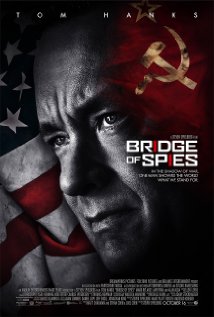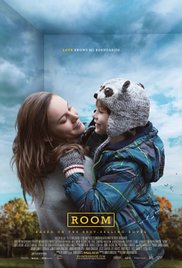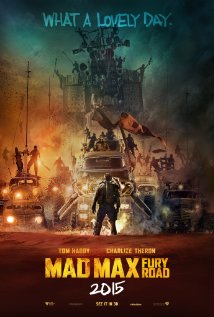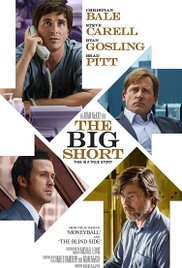Although it was unseasonably warm in DC on Day One of AMC Theaters' now-annual Best Picture Showcase, I was not to be dissuaded from my mission to spend ten hours indoors at the movies. Yes, the Oscars are upon us once again, and for me this time of year means wrestling with my annual desire to see all of the best picture nominees before awards night. Since the mid-aughts, AMC has been making this easier by bundling the nominated films and showing them back to back in two formats: half on each of the two Saturdays leading up to Oscar night, or in one epic sitting on the day before the big event. I've never dared the true marathon, but for the past several years I've managed one or both of the half-marathon options.
My last foray was in 2014, when I spent two intense movie-obsessed Saturdays at AMC's Hoffman 22 theater in Arlington, VA, and it was to the Hoffman I returned for the Day One screening this year to see "Bridge of Spies", "Room", "Mad Max: Fury Road" and "The Big Short".
As is my practice every year I quasi-live-Tweeted my observations throughout the day - of course my phone stayed tucked away during the movies, because I'm not a horrible person - so I was able to share my experience and mini-reviews via social media. My day went something like this:
9:30 am: Serious line outside @AMCTheatres Hoffman 22; I'll have lots of company for this year's Best Picture Marathon! #amcbps
I am pathologically tardy. I don't love this about myself but I acknowledge it, so when my arrival somewhere is time-sensitive I try to build in a few extra minutes to account for the fact that I'm likely to change my outfit four times, misplace my keys, or suddenly decide that all of my plants just have to be watered before I head out the door. I tried to get to the theater on the early side but things didn't quite work out, and when I arrived I was mighty surprised to see a line that started at the door, went down the street, and around the block; all these people waiting for the Best Picture Showcase?? As it turned out there was another event happening at the same time so the whole crowd wasn't there for the BPS, but while in line there was no way to tell this because
9:56am: Love @AMCTheatres but thumbs down on unwieldy pre-show traffic mgmt in Hoffman 22 lobby. I'm going...where??#signageplease #amcbps
To their credit, AMC Guest Services responded later that day to say thanks for the feedback and they'd passed it along to the Hoffman 22 crew. As it turned out I was not there for Day Two so not sure if they remedied the situation, but I appreciated the acknowledgement.
10:01am: Seat acquired, settling in, looking fwd to #bridgeofspies #madmax #room #thebigshort for Day One of #amcbps
I get stressed about the oddest things. Picking up and moving sight-unseen to the other side of the country? I've done it, no sweat. Running the NYC Marathon? Yeah, I got this. Long line and mass chaos at the movie theater? Oh-my-God-what-the-hell-is-the-holdup-I-need-to-find-my-seat-and-I-have-to-get-in-there-NOW!!!
About 75% of my trips to the theater are solo excursions so I've been able to hone my seat preferences to a pretty fine point, but I didn't realize just what a habit I'd developed until I sweated my way through the slow-moving Saturday morning crowd at the Hoffman 22, scurried into the assigned screening room, and with a sigh of relief plopped myself down in a seat about five rows back and toward the left of the screen. I'm happiest when I have a buffer of empty seats around me at the theater, so I usually go for seats that others would choose only as a last recourse, and I've learned to love the slightly off-kilter view afforded by my tendency to navigate to port and head dangerously close to the screen when choosing a seat. I'm not sure I could even bear to watch a movie straight-on anymore.
Being in year five of Best Picture Showcase viewership I've seen attendance ebb and flow. This year, I'm not sure that our assigned theater ever reached more than 50% capacity throughout the screenings. What I did notice were more comings and goings, with people changing seats between films or opting to skip some selections altogether. This drop-in approach reached its apex as "Room" was about to begin, when a guy in the row behind me stood up and announced to his friends that he was headed out for a round of golf and would be back for "Mad Max". Given the 60-degree February day unfolding outside, it seemed perfectly reasonable.
10:01am: Yay! #amcbps
The Hoffman crew ran a pretty tight ship for this year's Showcase, so all of the films started right on time and exactly according to schedule. Bravo! At 10am I settled in to watch Steven Spielberg's Cold War thriller, "Bridge of Spies".
12:26pm: So, #bridgeofspies built on strong performances but not sure it really connects as a true best picture contender #amcbps

"Bridge of Spies" is elegantly constructed; elements introduced in act one pay off by act three in ways that aren't immediately apparent, so it eventually becomes clear why we're introduced to Tom Hanks' James Donovan, an insurance lawyer, via a well-reasoned argument about whether an auto accident with multiple victims should be seen as one incident or several. And it takes some time to understand why, as Donovan is engaged to defend Abel in his trial for treason, a second plot line about military pilots and experimental aircraft is introduced, but we eventually get there.
"Bridge of Spies" is an interesting trip back to post-war America, and a reminder of the covert - and occasionally overt - paranoia and uncertainty that marked the Cold War era. The action switches over to Berlin as Donovan undertakes a negotiation with German and Soviet authorities to set up a prisoner exchange, and this is set against the construction of the Berlin Wall. It's easy now to forget the insanity of such a situation - a wall dividing a city, with armed guards and military encampments to keep people from going over it?? - or to think of it as a fiction straight out of the latest dystopian YA franchise. "Bridge" successfully recreates the world where such a thing really happened, and from the grimy and dismal streets of East Berlin to the scenes of American children earnestly watching a film on how to survive a nuclear blast, it's artful and authentic. Overall, "Bridge of Spies" is a solid offering, but nothing aside from Mr. Rylance's performance really sets it apart. I'm glad I saw it, but it doesn't get my vote for Best Picture.
12:37pm: Next up for #amcbps: #madmax. Curious to see how it holds up on second viewing & juxtaposed w Spielberg/Hanks feel-good flick #totalopposite
2:46pm: Ok, just saw #room, #madmax up next. How do I keep misreading sched?? #notthathard #tooearlytobetired #amcbps
Seriously, how?? When you walk in AMC gives you a lanyard with a big, shiny laminated pass on it, and the movie names and times are printed on the back. Also, there are posters at the entrance that provide, yes, the movie names and times. I'm blaming my excitement about seeing "Mad Max" a second time for this year's flub.
2:49pm: Amazingly, #Room even more emotional on 2nd viewing. Still stunned by @brielarson & @JacobTremblay. Unequivocally a must-see pic #amcbps

I still preferred the first half of the film, and learning about this unique universe through Jack's eyes, to the second half when the captives escape and Jack is introduced to the wider world. I've recommended "Room" to many people since I saw it in the fall, and the response has been consistent: "I want to see it, but isn't it depressing?" My answer remains the same too: contrary to possible expectations, "Room" is beautifully uplifting, thought-provoking, and poetic. It says so much about the survival instinct, the dual needs of self-identity and connections with others, and how we explore and accept the world, or fight to change it if necessary. And, you really won't believe the performances until you see it. So, see it.
5:11pm: Don't see it winning but #MadMax may get my vote for year's best pic: human story, epic scale, sheer filmmaking joy at work. #magic #amcbps

Well, I came into "Fury Road" without the benefit of having seen any of the previous "Mad Max" films, and I had no trouble picking up the threads. It's the future, and there's been some devastating war and/or environmental catastrophe that has rendered resources such as fuel and water extremely scarce. A local warlord controls access to water and has built up a stronghold around the oasis he commands, where he maintains an army of uber-loyal War Boys and takes captive young women as his unwilling "wives". Max (Tom Hardy) is kidnapped because his blood is valuable to the army, and he winds up in the midst of the chase when army commander Imperator Furiosa (Charlize Theron) attempts to rescue the captive wives and take them away to her long-forgotten homeland. The post-apocalyptic world that "Mad Max" depicts is harsh and unforgiving, but the story is about freedom and bounty and hope for the future.
It's fast-paced, and that pace is reinforced by a soundtrack that's filled with pulse-quickening drumbeats and crashing guitar riffs, but there are starkly beautiful quiet shots as well, such as a moment of grief for Furiosa that's framed against rosy-toned cliffs and an ocean of sand. The joy of "Mad Max" is watching how director George Miller uses film to bring to life his fiercely unique storytelling vision. It seems like a cliche to say that something "pushes the boundaries of filmmaking", but here it's a fit. Watching "Mad Max" the second time around I came to the conclusion that I was seeing a story that could only be told on film - it couldn't be a tv show, or a graphic novel, or a play - and that's one of the reasons why it's on my short list as Best Picture this year.
5:58pm: #TheBigShort up next at #amcbps. #ChristianBale never lets me down; I even liked #ReignofFire #sawitinthetheater #maybemorethanonce

8:28pm: #TheBigShort comes on gimmicky & self-indulgent, ultimately pays off; solid end to Day One of @AMCTheatres Best Picture Showcase. #amcbps
I went into "The Big Short" knowing the basics - story of the 2008 financial crisis, solid cast including Christian Bale, Steve Carrell, and Ryan Gosling, Best Director nomination for Adam McKay who's usually known for comedies - but that was about it. I found myself unexpectedly annoyed by the film's format and style at the beginning, as the story was laid out with lots of starts and stops and breaks in the action for meta-comments and explication. It's a unique and ultimately effective approach to laying out big chunks of contextual info on the economy, large-scale investment strategies, the housing market, and how Wall Street operates. But it also felt occasionally condescending and the choppiness made it difficult to get into the flow of the story. Once "The Big Short" eased into more traditional storytelling territory I warmed up to it, and it was fascinating and infuriating to learn how banking deregulation and high-wire investment tactics led to the collapse of the US housing market and subsequent financial meltdown in 2008.
Contrary to my expectations, Christian Bale's performance as fund manager Michael Burry, who foresees the possibility of profiting by betting against mortgage-backed securities by watching bellwether indicators in the housing industry, wasn't my favorite in the film. Rather, it was Steve Carrell as rival investor Mark Baum who stole the show. He progresses from caricature to character and ultimately emerges as a man whose outsized outrage is fueled by thwarted idealism. In a story filled with big egos and outrageous excess, the performance stands out, and I'm sure I'm not the first to say that the real "big short" is that Mr. Carrell was not nominated in either of the Best Actor categories this year.
So, that's a wrap on Day One of AMC's Best Picture Showcase. Next up: Day Two!